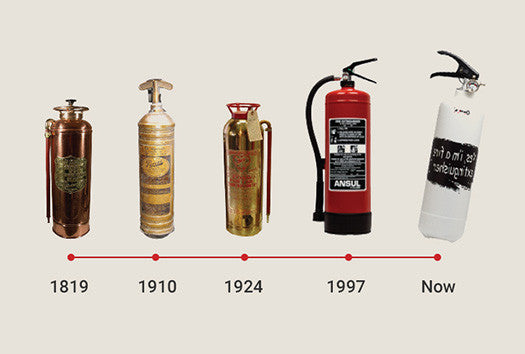
Around 200 BC
Ctesibius of Alexandria invented a hand pump able to deliver water to a fire.
During the Middle Ages
‘Squirts’ began to be used to apply jets of water to fires. The squirt worked much like a bicycle pump. The nozzle was dipped into water and about one liter was sucked up by pulling out the plunger. The charged squirt was then directed at the fire and the plunger pushed home to eject the water. Squirts were used on the 1666 Great Fire of London.
1723
The first automatic fire extinguisher of which there is any record was patented in England by Ambrose Godfrey, a celebrated chemist. It consisted of a cask of fire-extinguishing liquid containing a pewter chamber of gunpowder. This was connected with a system of fuses which were ignited, exploding the gunpowder and scattering the solution.
1818
The first version of the modern portable fire extinguisher was invented by Captain George William Manby, consisting of a copper vessel of 3 gallons (13.6 liters) of pearl ash (potassium carbonate) solution under compressed air.
1866
The soda-acid extinguisher was first patented in France by Francois Carlier. It mixed a solution of water and sodium bicarbonate with tartaric acid, producing the propellant CO2 gas.
1881
A soda-acid extinguisher was patented in the United States by Almon M. Granger. His extinguisher used the reaction between sodium bicarbonate solution and sulfuric acid to expel pressurized water onto a fire.1881
The cartridge-operated extinguisher was invented by Read & Campbell of England, which used water or water-based solutions. They later invented a carbon tetrachloride model called the “Petrolex” which was marketed toward automotive use.
1890s
A further variety was developed which consisted of a glass bottle “bomb” filled with the liquid that was intended to be hurled at the base of a fire. The CTC (carbon tetrachloride) vaporized and extinguished the flames by chemical reaction. CTC was suitable for liquid and electrical fires and the extinguishers were fitted to motor vehicles for the next 60 years. CTC extinguishers were withdrawn in the 1950s because of the chemical’s toxicity.
1904
The chemical foam extinguisher was invented by Aleksandr Loran in Russia, based on his previous invention of fire-fighting foam. 1912: The Pyrene Manufacturing Company of Delaware filed a patent for using carbon tetrachloride (CTC) to extinguish fires. The liquid vaporized and extinguished the flames by inhibiting the chemical chain reaction of the combustion process (it was an early 20th century presupposition that the fire suppression ability of carbon tetrachloride relied on oxygen removal). In 1911, they patented a small, portable extinguisher that used the chemical.
1924
The carbon dioxide (CO2) extinguisher was invented (at least in the US.. It consisted of a tall metal cylinder containing 7.5 lbs. of CO2 with a wheel valve and a woven brass, cotton covered hose, with a composite funnel-like horn as a nozzle. CO2 is still popular today as it is an ozone-friendly clean agent and is used heavily in film and television production to extinguish burning stuntmen.1928
DuGas (later bought by ANSUL) came out with a cartridge-operated dry chemical extinguisher. It consisted of a copper cylinder with an internal CO2 cartridge. The operator turned a wheel valve on top to puncture the cartridge and squeezed a lever on the valve at the end of the hose to discharge the chemical.
The 1940s
Germany invented the liquid chlorobromomethane (CBM) for use in aircraft. It was more effective and slightly less toxic than carbon tetrachloride and was used until 1969.
The 1950s
ABC dry chemical came over from Europe with Super-K being invented in the early 60s and Purple-K being developed by the US Navy in the late 1960’s.
The 1970s
Halon 1211 came over to the United States from Europe, where it had been used since the late 40s or early 50s. Halon 1301 was developed by DuPont and the US Army in 1954. Both 1211 and 1301 work by inhibiting the chain reaction of the fire and, in the case of Halon 1211, cooling class A fuels as well. Halon is still in use today, but is falling out of favor for many uses, due to its environmental impact.
Till today
Mono Ammonium Phosphate was the newest agent used in today portable fire extinguisher as main agent.

